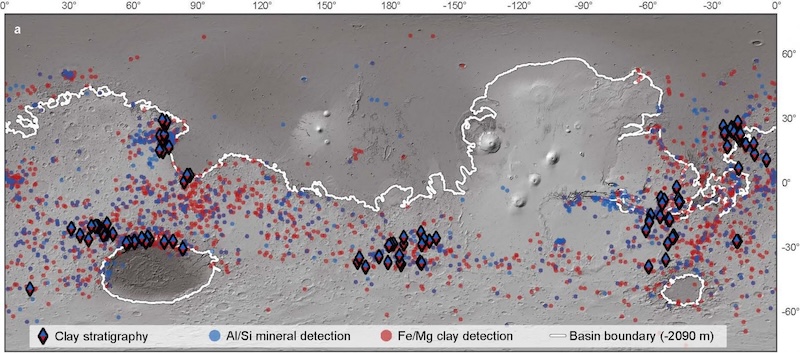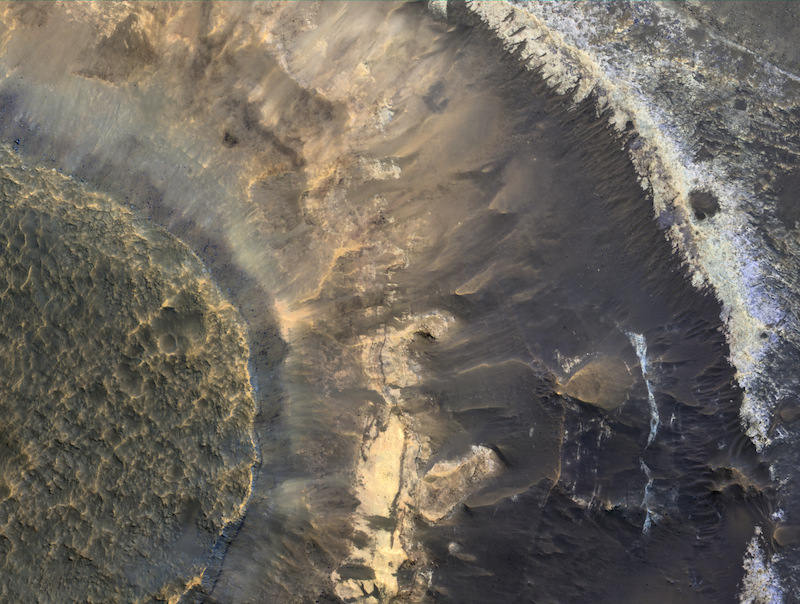- Clays are ideal for preserving traces of ancient life on Earth. Could the same be true on Mars?
- Layers of clay, up to hundreds of feet thick, are common on Mars. A new study from a team of researchers in the U.S. shows they formed alongside standing bodies of liquid water on ancient Mars.
- This environment was likely stable enough for microbes to live in, if they ever existed.
Clays on Mars
Clays are some of the best kinds of terrain to preserve traces of ancient life, at least on Earth. They are rich in minerals and require water to form. So what about on Mars? A team of researchers, led by the University of Texas at Austin, conducted a new study of thick clay layers on Mars. The researchers said on June 16, 2025, that most of the clay layers formed alongside standing bodies of surface liquid water, such as lakes. This environment could have been calm and stable enough to provide an ideal habitat for microbes.
These clay layers can be up to hundreds of feet deep. And they can be found in many locations on Mars. So, how did they form?
The researchers published their peer-reviewed findings in Nature Astronomy on June 16, 2025.
Thick clay layers on Mars
Clays are common on Mars. In fact, there are widespread layers of clay all over the planet. These layers are also thick, up to hundreds of feet deep. They are similar to thick layers of clay in tropical regions on Earth. The Martian clays formed billions of years ago, when the planet was much wetter than it is today.
And on Earth, clays can preserve traces of ancient life. Is that also the case for Mars?
They Might Be ClaysThis observation targets a region of layered materials exposed along the northern edge of the Hellas Basin. These layers have a light tone, suggesting the presence of clays.uahirise.org/hipod/ESP_08…NASA/JPL-Caltech/University of Arizona#Mars #science #NASA
— HiRISE BeautifulMars (NASA) (@uahirise.bsky.social) 2025-03-02T18:00:18.394Z

A stable, habitable environment
The thick clay deposits are rich in minerals. Combined with the adjacent bodies of water, they could have been well-suited not only for preserving traces of past life, but also sustaining stable, habitable conditions for microbial life billions of years ago. Lead author Rhianna Moore at the University of Texas’ Jackson School of Geosciences said:
These areas have a lot of water but not a lot of topographic uplift, so they’re very stable. If you have stable terrain, you’re not messing up your potentially habitable environments. Favorable conditions might be able to be sustained for longer periods of time.
With this in mind, the researchers examined images and other data from 150 known clay deposits on Mars. NASA’s Mars Reconnaissance Orbiter (MRO) had previously mapped out the locations of these clay layers. Most of the clays are near former lakes and are similar to clay deposits on Earth. Co-author Tim Goudge is an assistant professor at the Jackson School’s Department of Earth and Planetary Sciences at the University of Texas at Austin. He explained:
On Earth, the places where we tend to see the thickest clay mineral sequences are in humid environments, and those with minimal physical erosion that can strip away newly created weathering products. These results suggest that the latter element is true also on Mars, while there are hints at the former as well.

Formation of clays on Mars similar to Earth, yet different
Indeed, the clays are further evidence that Mars was once much more Earthlike. But, in addition, they also reveal distinct differences. The reason has to do with plate tectonics. Earth’s crust is divided into plates that can move on top of the mantle below. They expose fresh rock that interacts with water and carbon dioxide. Mars, however, never had plate tectonics.
Also, when Mars’ volcanoes released carbon dioxide into the atmosphere eons ago, there was no source of fresh rock for the gas to interact with. So consequently, it just lingered in the atmosphere. As a result, the planet became warmer and wetter. The researchers said that is how these Martian clays likely formed. The end product was similar to clays on Earth, but the formation process was a bit different.
Puzzle of the missing carbonates
The lack of fresh rock could also help explain another Martian mystery: the seeming lack of extensive carbonates. Carbonates are chemical compounds derived from carbonic acid or carbon dioxide. The lack of newly created fresh rock could have impeded the chemical reactions needed to form carbonate rock. Then, the ongoing formation of clays might have also contributed to the lack of carbonates. It would have sucked up water and sequestered chemical byproducts in the clay. As a result, this would have prevented them from leaching out into the wider environment, where they could react with the surrounding geology. As Moore noted:
It’s probably one of many factors that’s contributing to this weird lack of predicted carbonates on Mars.
However, on that note, another international team of researchers said last April that NASA’s Curiosity rover found rich deposits of carbonates in rocks in Gale crater. The evidence suggests there might indeed be a lot of carbonates on Mars after all, which just haven’t been identified yet.
Bottom line: A new study shows that thick layers of clays on Mars formed close to bodies of water like lakes. This might have provided a stable environment for life.
Source: Deep chemical weathering on ancient Mars landscapes driven by erosional and climatic patterns
Via Texas Geosciences/ The University of Texas at Austin
Read more: New discovery of carbonates on Mars could solve big mystery
Read more: Ancient ‘honeycomb’ mud on Mars boosts chances for life
